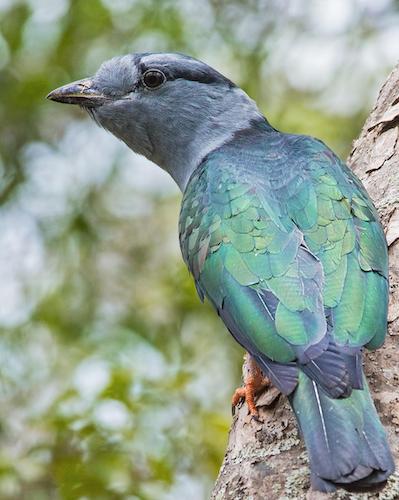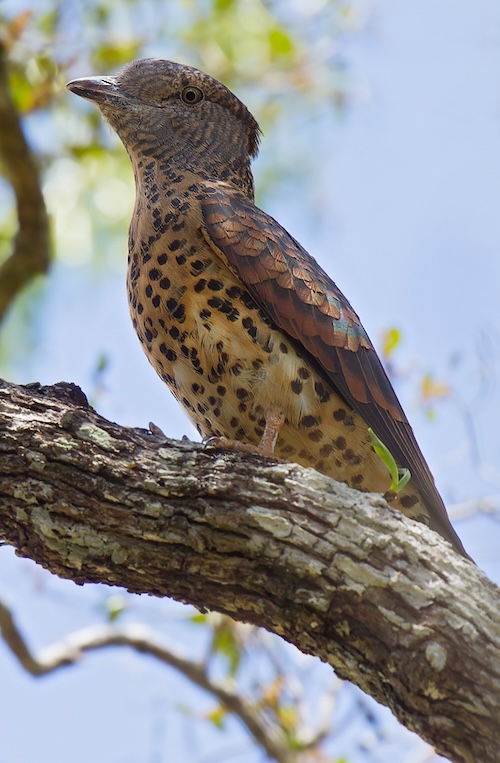Leptosomatidae – Cuckoo Roller

The Leptosomidae familly is represented by just one bird the cuckoo roller or courol, which used to be placed in the order Coraciiformes, which also includes the kingfishers, bee-eaters and rollers. However, its position is not very clear. Morphological evidence may suggest a placement in or near to Falconiformes. In the rather comprehensive DNA study by Hackett et al, this and the Hoatzin are the only two birds whose position is unclear, although the Cuckoo-roller seems to be at the root of a group that contains the Trogoniformes, Bucerotiformes, Piciformes, and Coraciiformes. It is now considered to be the sole representative family of Leptosomiformes.
It is a medium-large bird, inhabiting forests and woodlands in Madagascar and the Comoro Islands. Three subspecies are described: the nominate L. d. discolor is found in Madagascar and Mayotte Island, L. d. intermedius on Anjouan, and L. d. gracilis of Grand Comoro. Based on its smaller size, differences in the plumage, and minor difference in the voice, the last of these has sometimes been considered a separate species, the Comoro cuckoo roller (L. gracilis).
The cuckoo roller occupies a wide variety of habitats, including altered areas. They inhabit forest, including rainforest, litoral forest, deciduous forest, spiny bush-forest, and tree plantations. In the Comoros, the species is found on all the major islands, particularly in forested zones. It can be found from near sea level up to 2000m.
Their diet is not well known, but a 1931 expedition found that chameleons and insects, particularly locusts and caterpillars, are important food items. Stomachs have often been found to be lined with caterpillar hairs, and other prey taken include grasshoppers, cicadas, stick insects, and geckos. The principal foraging technique is to perch motionless, watching for prey, then to make a quick sally towards the prey when observed. They also hunt from the air. Prey is caught in the large bill and killed by beating it against a branch.
Very few studies have investigated their breeding habits. It has been described in the past as a polygamous breeder, but no evidence for this is available. The nest is located in tall trees, 4m to 6m off the ground, in natural cavities. No lining is placed inside the cavity; the white eggs are laid directly on the bottom. The usual clutch size is around four eggs. Incubation is performed by the female only, while the male feeds her. The incubation period is about twenty days, after which fluffy chicks are born. Chicks remain in the nest for thirty days before fledging.

Cuckoo-Roller Leptosomus discolor – ©Dubi Shapiro
The species has a total length of 40cm to 50cm; the nominate subspecies is the largest, and L. d. gracilis the smallest. Unlike the true rollers and ground rollers, where the sexes have identical appearance, the cuckoo roller is sexually dichromatic. Males have a mostly velvety grey chest and head, changing gradually to white on the remaining underparts (the demarcation between grey and white is stronger in L. d. gracilis). The back, tail, and wing-coverts are dark iridescent green with a purplish tinge (especially on the wing-coverts), and the crown and eye-stripe are black. Females are mostly brown, with strongly dark-spotted pale underparts (less spotting in L. d. gracilis). Juveniles are generally reported as resembling a dull female, but at least juveniles of L. d. gracilis are sexually dimorphic, and this also possibly applies to the other subspecies. The bill is stout and the eyes are set far back in the face. The legs and feet are small, and the feet have an unusual structure which has confused many ornithologists, but is now thought to be zygodactylous (two toes forwards, two toes backwards).
-
Number of bird species: 1
(As at August 2025)
There is jiust one extant member of the Leptosomidae family:
Cuckoo-Roller Leptosomus discolor
There are three sub-species currently recognised. They are:
Leptosomus discolor gracilis (Milne-Edwards & Oustalet, 1885 Grand Comoro I.) (Comoro Islands)
Leptosomus discolor intermedius (Hartert & Neumann, 1924 Anjouan I) (Comoro Islands)
Leptosomus discolor discolor (Hermann, 1783) Mayotte I. and Mohéli (Comoro Islands)
-
Cuckoo-Roller Leptosomus discolor
Species AccountThis account summarizes the life history of the Cuckoo-roller, including information relating to its identification, systematics, distribution, habitat, diet, vocalizations, breeding ecology, and conservation status. -
Cuckoo-Roller Leptosomus discolor
Species AccountThis species has a very large range, and hence does not approach the thresholds for Vulnerable under the range size criterion (Extent of Occurrence <20,000 km2 combined with a declining or fluctuating range size, habitat extent/quality, or population size and a small number of locations or severe fragmentation). -
Cuckoo-Roller Leptosomus discolor
Species AccountMales have a pale head and underparts and a colorful iridescent back. Females are rufous brown with heavy spotting below. Found in all forest types... -
Cuckoo-Roller Leptosomus discolor
Species AccountThe cuckoo-roller or courol (Leptosomus discolor) is the only bird in the family Leptosomidae... -
Cuckoo-Roller Leptosomus discolor
Species AccountSound archive and distribution map.
